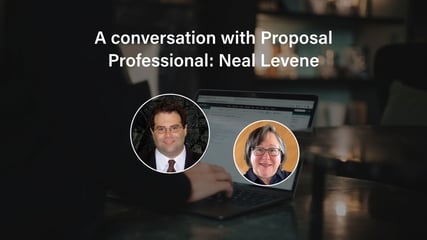Effective proposal management is the process of planning, coordinating, and improving how teams respond to bids. Done right, it transforms disconnected efforts into a high-performing proposal team that works smarter, not harder.
Whether you’re managing proposals for a global enterprise or a niche service firm, a structured and collaborative process is key to producing high-quality proposals that improve your win rate and support business development goals.
Best Practices: Include the Proposal Manager Early
The proposal development process should begin well before writing. It starts with bid qualification—the moment business development spots an opportunity worth pursuing.
Problem: Proposal managers are often brought in too late. This creates a knowledge gap between what sales knows and what the proposal team needs to deliver a compelling proposal.
Best practice: Bring the proposal manager into the qualification stage. Give them full access to customer background, competitive intelligence, and the early solution strategy. This ensures better alignment, faster ramp-up, and fewer errors.
A proposal manager who understands the capture strategy can proactively plan around team availability, identify reusable content, and tailor the workflow to meet tight deadlines.
Align Early with a Capture Strategy Discussion
A capture strategy provides the foundation for writing a winning proposal. It outlines the customer’s needs, your differentiators, competitive positioning, teaming, and pricing strategy.
Problem: Teams often receive the capture strategy document without discussion. This leads to misunderstandings, fragmented narratives, and inefficient proposal development.
Best practice: Schedule a team-wide capture strategy discussion. Let writers, SMEs, and reviewers ask questions, identify gaps, and suggest refinements. This builds buy-in and ensures everyone is working from the same playbook.
An open dialogue sets expectations, reveals inconsistencies early, and speeds up the proposal development process. It also helps SMEs connect their technical expertise to the customer’s actual pain points.
Use Centralized Collaboration Tools
Modern proposal teams are distributed—geographically and functionally. Relying on email chains to align on strategy or manage reviews can waste hours and create version chaos.
Problem: Email threads get messy fast. Important details are missed, feedback is duplicated, and consensus is rare.
Best practice: Centralize proposal discussions using proposal software with collaboration tools. These platforms let team members comment directly on documents, review previous decisions, and tag others for input.
This approach supports real-time visibility, tracks decision history, and gives the proposal manager better control over the process. It also helps your proposal team stay focused under tight deadlines.
Build a Pre-Writing Plan That Sets the Tone
Proposal writing is a collaborative process. Teams that skip planning end up stitching together disconnected pieces with inconsistent tone and messaging.
Problem: Without alignment on style, structure, or win themes, even experienced SMEs can create gaps that confuse evaluators.
Best practice: Before writing begins, hold a planning session to review the capture strategy, outline the scoring criteria, and break down key messaging.
Clarify what a strong section looks like. Define tone, voice, and required proof points. Share past examples of successful proposals. This gives the team confidence and saves time during revisions.
Learn From Professional Proposal Managers:


Tailor Reusable Content with Intent
Reusable content can reduce writing time—but only if it’s tailored to the specific opportunity.
Problem: Copy-pasted content feels generic. Evaluators can tell when a proposal lacks personalization and may view it as careless or low-effort.
Best practice: Start with reusable material but revise it to align with the customer’s context. Use their language. Reference their pain points. Show how your solution addresses their goals.
Highlight what’s in it for them, not just what you offer. When proposal content speaks directly to a buyer’s need, it builds credibility and improves proposal quality.
Set Review Expectations and Roles
Proposal reviews are critical to effective proposal management—but only when reviewers know what to look for and how to provide helpful input.
Problem: Vague feedback like “this section needs work” creates more confusion than clarity. It forces writers to guess what reviewers mean.
Best practice: Assign specific focus areas to each reviewer: one for compliance, another for solution accuracy, another for voice and tone. Instead of asking for “feedback,” ask reviewers to provide clear instructions.
Example: Instead of “this is weak,” a helpful comment would be “add a proof point to support our claim about reducing onboarding time.”
Structured reviews lead to better revisions, higher proposal quality, and fewer unnecessary rewrites.
Collaborate in Real Time to Build Consensus
Effective proposal management isn’t just about collecting feedback—it’s about building agreement across your team.
Problem: When reviewers work in isolation, they leave conflicting suggestions. Writers then have to resolve disagreements on their own.
Best practice: Use tools that allow reviewers to see and respond to each other’s comments. When reviewers collaborate in real time, they’re more likely to align on solutions—and less likely to leave ambiguous instructions.
When your proposal team can reach consensus efficiently, it frees up time to focus on writing improvements that actually increase your win rates.
Elevating Proposal Quality Through Story, Context, and Final Revisions
Strong proposal management doesn’t stop at writing and review—it continues through narrative structure, tone, and strategic revisions. These elements shape how evaluators perceive your solution, and whether they feel confident awarding you the contract.
The final phase of the proposal development process is where good proposals become great. With the right approach, your proposal team can turn draft content into a persuasive, evaluator-focused submission that boosts win rates.
Use Narrative to Connect with Evaluators
Proposal writing isn’t just technical writing—it’s business storytelling. Evaluators don’t just want answers; they want clarity, relevance, and confidence that your team understands their needs.
Problem: Many proposals feel disjointed or overly formal. They describe the solution but fail to build a compelling story around it.
Best practice: Structure each section like a mini-narrative:
- Setup: What is the customer’s current situation or challenge?
- Conflict: Why is that situation no longer sustainable? What’s at risk?
- Resolution: How does your solution resolve their pain point—specifically?
This narrative approach makes your proposal more readable and memorable. It also reinforces your win themes without relying on repetition or filler.
When reviewers feel you “get” their world, your proposal becomes more than a response—it becomes the logical next step.
Build Context That Supports Intent
Great proposals are written with intent: to persuade, inform, and guide evaluators toward a favorable decision. But that intent is only effective when grounded in context—the buyer’s industry, situation, priorities, and pressure points.
Problem: Proposals that reuse generic content often miss the mark. They feel out of touch with what the customer is actually experiencing.
Best practice: Clarify your intent before you revise. Ask:
- Why are we writing this proposal?
- What does the evaluator want to hear?
- What do we want them to remember?
Then, refine each section to reflect the evaluator’s real-world context. Use examples pulled from the capture strategy or pre-bid conversations. Incorporate terminology that matches their language. Address their likely concerns head-on.
Proposal management means managing meaning—not just words.
Strengthen Proposal Tone and Authenticity
Tone is how your proposal sounds to the reader. It reflects your company’s professionalism, confidence, and values. Authenticity is whether the reader believes you mean what you say.
Problem: When multiple writers contribute without coordination, tone suffers. Sections can feel cold, inconsistent, or overly technical.
Best practice: During the improvement phase, review tone intentionally. Ask:
- Does this sound confident, or cautious?
- Is our tone collaborative and respectful—or just transactional?
- Does it reflect how we really work with clients?
Simple language and assertive phrasing go a long way. Use “we will” instead of “we aim to.” Speak directly and positively. Avoid unnecessary jargon. Make your proposal feel like a conversation between experts.
Authenticity builds trust. A confident, clear, and empathetic tone can make the difference between a good score and a winning one.
Free eBook: Tips and Tricks for Winning Proposals
Create a Final Improvement Plan
As you enter final revisions, it’s time to shift from writing to improving. Treat the Improvement phase as its own project—structured, time-boxed, and strategic.
Problem: Without structure, revisions can lead to last-minute scrambles. Teams fix surface issues but miss deeper inconsistencies.
Best practice: Assign improvement leads by section. Focus reviews on specific criteria:
- Compliance and completeness
- Evaluator relevance
- Proof and differentiation
- Readability and flow
Use a heatmap-style system to tag issues (e.g., red = rewrite, yellow = clarify, green = approved). This gives the proposal team a visual map of what needs attention—fast.
Also, schedule a short debrief session between reviewers and writers to clarify any vague comments. Avoid assumptions at this stage. Clear instructions lead to meaningful revisions.
Reframe Reviewer Feedback as Instructions
You’ve likely seen review comments like: “This section is weak.” Not helpful.
Problem: General feedback wastes time and leads to guesswork during revision.
Best practice: Ask reviewers to leave instructions, not feedback. “Add a proof point about onboarding time” is useful. “This feels light” is not.
Proposal managers can even categorize comments during reviews (e.g., compliance, content strength, tone) to prioritize what gets fixed first— especially when deadlines are tight.
Encouraging clear reviewer instructions is a hallmark of effective proposal management.
Use Strategic Repetition for Emphasis
Even well-written proposals may get skimmed. Evaluators bounce between sections, compare competitors, and return to key areas during scoring.
Best practice: Use strategic repetition to reinforce your message:
- Repeat win themes subtly across sections
- Rephrase key points in the executive summary and conclusion
- Include visual callouts, quotes, or results that support your central claims
This boosts message retention and makes your proposal content easier to navigate—especially in long or complex submissions.
Final Review: Tone, Flow, and Walkaway Message
In your last pass, zoom out. Does the proposal feel cohesive? Does it reflect your brand? What impression will it leave?
Best practice: Do a “walk-away” test:
- If the evaluator skims this proposal, what will they remember?
- Does every section answer “what’s in it for me” from their perspective?
Make sure the proposal quality holds from the cover letter to the last appendix. Trim fluff. Reword long sentences. Add clarity wherever meaning feels murky.
Build a Culture of Continuous Improvement
Managing proposals isn’t just about delivering one good submission—it’s about improving with every bid.
Best practice: After delivery, host a proposal retrospective. Review:
- What worked well?
- Where did timelines slip?
- Which SMEs or reviewers added the most value?
Use those insights to strengthen your proposal management framework. Over time, you’ll reduce effort, increase consistency, and keep improving your win rate.
Proposal Management Best Practices Summary
Proposal management is more than project management. It’s about:
- Empowering your proposal team
- Connecting strategy to writing
- Using reviews to build consensus, not conflict
- Writing with intent, clarity, and empathy
- Refining content to resonate with evaluators under pressure
By following these proposal management best practices, you’ll deliver high-quality proposals that win more often—and win more confidently.









